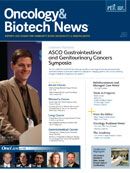Publication
Article
Oncology & Biotech News
EBRT More Toxic, Costly Than Radical Prostatectomy or Brachytherapy
Author(s):
EBRT led to more long-term toxicity and higher treatment-related costs compared with radical prostatectomy or brachyherapy.
Jay P. Ciezki, MD
External-beam radiation therapy (EBRT) led to more long-term toxicity and higher treatment—related costs compared with radical prostatectomy or brachyherapy, two other treatments for prostate cancer. These somewhat surprising results were presented at the recent ASCO Genitourinary Cancers Symposium by Jay P. Ciezki, MD, Department of Radiation Oncology at the Cleveland Clinic in Ohio.
“Although these treatments are commonly used, comparative effectiveness and cost studies are lacking. Our research shows that of a group of common therapies for prostate cancer, external beam radiation is the most toxic and the most costly,” Ciezki said.
The investigators used the Surveillance Epidemiology and End Results (SEER)-Medicare database from 1991 to 2007 to study 137,427 patients diagnosed with prostate cancer who were aged ≥65 years and had prostate cancer as their only diagnosis. Of these, 59,559 (43%) were treated with prostatectomy, 60,806 (44.2%) received EBRT, and 17,062 (12.4%) received brachytherapy.
After 15 years of follow-up, the cumulative incidence of genitourinary (GU) toxicity was significantly higher for EBRT (approaching 20% of patients) than for prostatectomy (about 7%) or brachytherapy (about 5%; P <.001 for both comparisons). The cumulative incidence of gastrointestinal (GI) toxicity was also significantly higher with EBRT than for prostatectomy or brachytherapy (P <.0001 for both comparisons). Rectal bleeding was the most common GI toxicity, occurring in more than 50% of patients with GI toxicity.
“Patients treated with EBRT have many more events over time than patients in the other two groups. After 15 years, they top out at 2.5%, so the overall amount of GU toxicity is relatively small, but not insignificant for patients who have it,” Ciezki said.
The treatment-related cost per patientyear was $6412.29 for EBRT, $3205.71 for prostatectomy, and $2557.36 for brachytherapy (P <.0001 for all comparisons).
Despite having the lowest incidence of side effects as well as the lowest cost, only about 12% of patients were treated with brachytherapy, while 44% had radical prostatectomy and 44% had EBRT.
Nicholas J. Vogelzang, MD, moderator of the presscast at which this study was discussed, said, “Although brachytherapy won the trifecta as the least toxic and least expensive therapy, it was the least used. Perhaps doctors are becoming more comfortable with it now in 2012 versus 2007, the last year of the study. The lower cost is impressive, and I’m surprised we don’t see more use of that modality.” Vogelzang is chair and medical director of the Developmental Therapeutics Committee at US Oncology Research, Las Vegas, Nevada.
Leonard G. Gomella, MD
Leonard G. Gomella, MD, another prostate cancer expert, said that invasive or minimally invasive treatments such as prostatectomy and brachytherapy that require being in the operating room and anesthesia are generally perceived as less safe than treatments such as EBRT. “What we see in this study is a suggestion that patients receiving EBRT may not be as safe as presumed in avoiding side effects of so-called more invasive treatments,” he said.
Regarding the cost of treatment, Gomella said, “In our cost-conscious environment, we need to pay attention to costs spiraling out of control. The average cost per patient-year for EBRT was twice as expensive as radical prostatectomy and 2.5 times as expensive as brachytherapy.”
“
In our cost-conscious environment, we need to pay attention to costs spiraling out of control. The average cost per patient-year for EBRT was twice as expensive as radical prostatectomy and 2.5 times as expensive as brachytherapy.”
—Leonard G. Gomella, MD
Despite these findings, Gomella emphasized the importance of individualizing therapy for each patient. “It is difficult to give broad brush recommendations. Every treatment can have unique side effects, and every treatment is a double-edged sword.” Gomella is chair of the Department of Urology at Thomas Jefferson University Kimmel Cancer Center in Philadelphia, Pennsylvania.


































%20(2)%201-Recovered-Recovered-Recovered-Recovered-Recovered-Recovered-Recovered-Recovered-Recovered-Recovered-Recovered-Recovered-Recovered-Recovered-Recovered-Recovered-Recovered.jpg?fit=crop&auto=format)
%20(2)%201-Recovered-Recovered-Recovered-Recovered-Recovered-Recovered-Recovered-Recovered-Recovered-Recovered-Recovered-Recovered-Recovered-Recovered-Recovered-Recovered-Recovered.jpg?fit=crop&auto=format)
